ESG - THE BASICS
CARBON INTENSITY AND TARGETS
Carbon intensity is often a good indication of where to begin looking for ways to reduce your carbon footprint by improving efficiencies and setting targets...

What is carbon intensity vs carbon emissions?
An organisation’s or household’s carbon footprint is the total amount of carbon emissions they cause, directly or indirectly, through all of their actions. But each separate action has a different carbon cost, so it can be helpful to consider the amount of carbon emissions per action: that’s the carbon intensity. Carbon intensity is often a good indication of where to begin looking for ways to reduce your carbon footprint by improving efficiencies and setting targets.
What sort of Climate Related Targets should we set?
Targets should include a baseline year and the target year, where the base year is the year against which GHG reductions are tracked. The year in which the target will be met should be 5 to 10 years from the base year, as well as setting a long-term target for 2050.
Typically, companies choose a baseline year between 2016 and 2020, depending on when they have the most up to date records.
Best Practice: Set a GHG reduction target below your 2005 emissions level by 28% to be met in 2025 and 45% in 2030. Also set a long-term target of zero or near-zero GHG emissions by 2050 with a minimum 4.2% reduction per annum for each year.
What carbon targets do I need to set to be GHG Protocol Compliant?
The GHG Protocol and the Science Based Targets Initiative are widely recognised accounting tool guidelines for organisations to measure and manage their Greenhouse Gas emissions (GHGe). They provide a standardised framework for identifying, measuring, assessing, tracking and reporting emissions. The goal is to develop a statement that clearly and simply states your organisation’s GHG target and conversion to a low or zero carbon emission generating organisation.
WHAT SORT OF TARGETS SHOULD YOU SET AND HOW TO TO DO IT?
What sort of targets should you be setting and how to work out the metrics, monitoring and assessment system to support them?
1. Reduce Carbon Emissions
Set a target to reduce your carbon footprint by a certain percentage over a specific time period. This can be achieved through energy efficiency measures, transitioning to renewable energy sources, and promoting sustainable practices.
2. Increase Energy Efficiency
Aim to improve your energy efficiency by implementing measures such as upgrading appliances inefficient or poorly maintained, optimising heating and cooling systems, and reducing energy waste. Set specific targets for energy consumption reduction for each activity that creates an emission.
3. Transition to Renewable Energy
Set a goal to increase the share of renewable energy sources in your energy consumption. This can involve installing solar panels, purchasing renewable energy credits, or supporting community renewable projects.
4. Water Conservation
Establish targets to reduce water consumption by implementing water-saving technologies, promoting responsible water use practices, and minimising water waste.
5. Waste Reduction
Set goals to minimise waste generation and increase recycling rates. Implement strategies like composting, waste segregation, re-purposing, and promoting sustainable packaging solutions. Aim for zero-waste.
6. Sustainable Transportation
Aim to reduce the carbon footprint of transportation by promoting alternatives to fossil fuel-powered vehicles. Set targets for increasing the use of public transportation, cycling, walking, or electric vehicles.
7. Reforestation and Conservation
Consider setting targets to support reforestation efforts, biodiversity regeneration or protect and conserve natural habitats. This can involve planting trees, supporting biodiversity initiatives, or participating in conservation projects.
Remember: make your targets specific, measurable, achievable, relevant, and time-bound (SMART). Adapt them to your specific circumstances and regularly track progress to ensure you stay on track to achieve your climate-related goals.
Assessing the Organisation’s Impact on the Climate and Identifying Key Sources
Assessing your organisation’s impact on the climate involves mapping your greenhouse gas (GHG) emissions and identifying the sources that contribute to your carbon footprint, this involves building a Greenhouse Gas emission inventory. This assessment identifies Scope 1, 2 and 3 emissions, which can then be used to choose a Baseline Year for measuring progress and identifying areas for improvement.
Scenario and Resilience Analysis
Using the Locate, Evaluate, Assess, Prepare (LEAP) framework, begin by describing how your organisation’s activities (including up and downstream activities) may be dependent or influenced by climate-related factors. For each identified activity, evaluate the dependencies and potential impacts (availability, quality, cost, and reliability) associated with climate change. Then conduct a risk assessment to identify climate-related risks and opportunities that may affect each activity and present your findings in a Climate Resilience Strategy Report.
Target Setting and Transition Plan
Target setting involves establishing an emissions target for each organisational activity and then totalling the target emissions per year, such that you establish targets for reducing GHG emissions by 2030 and then by 2050. An example of an organisational target is ‘to reduce GHG emissions by 50% by 2030, compared to a baseline year of 2016, across all operations and supply chain, and by 95% by 2050’.
Establishing a long-term target and transition plan involves defining your emissions mitigation pathway, for which we recommend the Absolute Contraction Approach (ACA). Other elements include setting renewable energy usage targets. Identifying energy efficiency actions, reducing waste, transportation and supply chain emissions.
Monitoring and Tracking Progress
Your organisation must describe how it will establish mechanisms for monitoring and tracking progress in implementing climate-related actions and achieving its mitigation targets, we recommend integrating ESG Report Pro into regular organisational reporting schedules. By effectively monitoring and tracking progress, the organisation can assess the effectiveness of its strategies, identify areas for continuous improvement, and ensure transparency in reporting.




